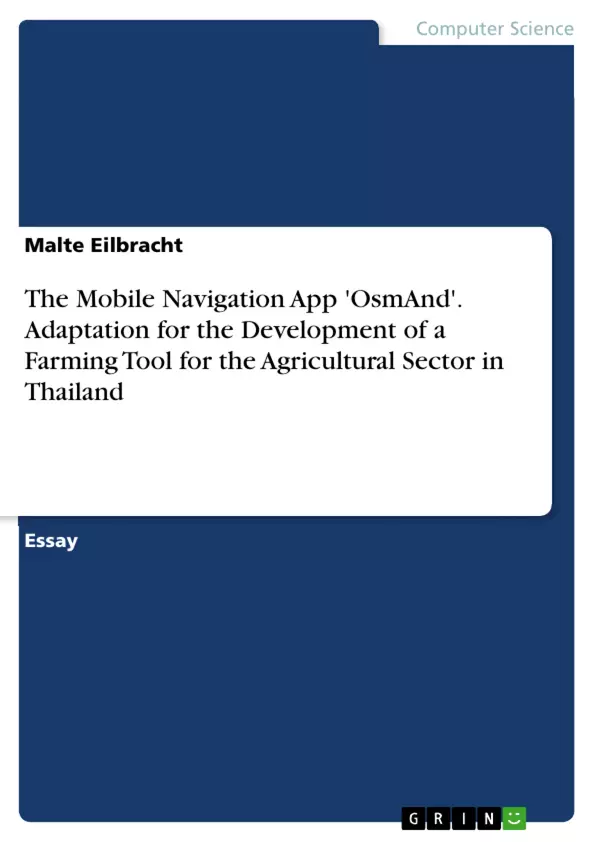The first part of the essay introduces the map application OsmAnd. The main business processes will be outlined using a flow diagram before illustrating the applications value proposition and revenue model. Finally a SWOT-analysis will identify the application's strength to be the deployment of mobile map data, the customisation of map rendering and the ability of trip recording, audio and video notes and OSM editing.
The second part of the essay uses a PEST-analysis to identify developing potential in a developing country, which was chosen to be Thailand. In consideration of the identified strengths of OsmAnd, the development of the agricultural sector was chosen for further investigation. A short summary of the current situation of the agribusiness follows.
The third part of the essay matches the insights from the SWOT- and PEST-analyses to create a new business model. The model is then outlined in a similar manner as initially OsmAnd. Business processes are outlined with the support of a flow diagram, before the changes in value proposition and revenue model are discussed.
The fourth part of the essay sketches potential risks identified during the design process of the new business model and their solution approaches, before concluding that the new model relies on the contribution of the users and the Thai government. Finally it will be recommended that a good stakeholder management will be needed to overcome the threat caused by these dependencies.
Inhaltsverzeichnis (Table of Contents)
- 1. Introduction
- 2. Analysis of OsmAnd
- 2.1 Introduction of the application and its basic features
- 2.2 Analysis of the business model
- 3. Identification of possible contribution to the e-commerce in a developing country
- 4. Discussion of the new business model
- 5. Outline of identified possible risks
- 6. Conclusion
Zielsetzung und Themenschwerpunkte (Objectives and Key Themes)
This essay examines the mobile map application OsmAnd and explores its potential for adaptation as a farming tool in Thailand. It begins by analyzing the application's current business model, identifying its strengths, and evaluating its potential for global competition. The essay then uses PEST analysis to identify opportunities for e-commerce development in Thailand, focusing on the agricultural sector. Based on this analysis, a new business model for OsmAnd is developed, specifically tailored for the Thai agricultural sector. Finally, the essay discusses potential risks associated with this new model and suggests solutions for mitigating them.
- Analysis of the OsmAnd application's business model and its strengths
- Identification of potential for e-commerce development in Thailand
- Adaptation of OsmAnd as a farming tool for the Thai agricultural sector
- Development of a new business model tailored to the Thai agricultural sector
- Assessment of potential risks and proposed solutions for the new business model
Zusammenfassung der Kapitel (Chapter Summaries)
- Chapter 1: Introduction: This chapter introduces the concept of a "tiger's stripes" as an analogy for the unique value proposition of a mobile application. It establishes the goal of analyzing OsmAnd's current business model and developing a new model for a specific environment.
- Chapter 2: Analysis of OsmAnd: This chapter provides an overview of OsmAnd's features, including its use of OpenStreetMaps data, its availability on Android and iOS, and its key functionalities such as offline maps, trip recording, and OSM editing. It then analyzes the application's business model, outlining its processes, value proposition, and revenue model.
- Chapter 3: Identification of possible contribution to the e-commerce in a developing country: This chapter utilizes PEST analysis to assess the potential for e-commerce development in a developing country, specifically Thailand. It identifies the agricultural sector as a target area for OsmAnd's adaptation.
- Chapter 4: Discussion of the new business model: This chapter outlines the development of a new business model for OsmAnd, tailored for the Thai agricultural sector. It explains the changes in value proposition and revenue model, and presents a flow chart of the new business process.
- Chapter 5: Outline of identified possible risks: This chapter identifies potential risks associated with the new business model, focusing on dependencies on user contributions and government support. It proposes solutions to mitigate these risks, emphasizing the importance of stakeholder management.
Schlüsselwörter (Keywords)
OsmAnd, mobile map application, OpenStreetMaps, e-commerce, developing country, Thailand, agricultural sector, business model, value proposition, revenue model, PEST analysis, SWOT analysis, risk management, stakeholder management.
- Quote paper
- Malte Eilbracht (Author), 2016, The Mobile Navigation App 'OsmAnd'. Adaptation for the Development of a Farming Tool for the Agricultural Sector in Thailand, Munich, GRIN Verlag, https://www.grin.com/document/342221



